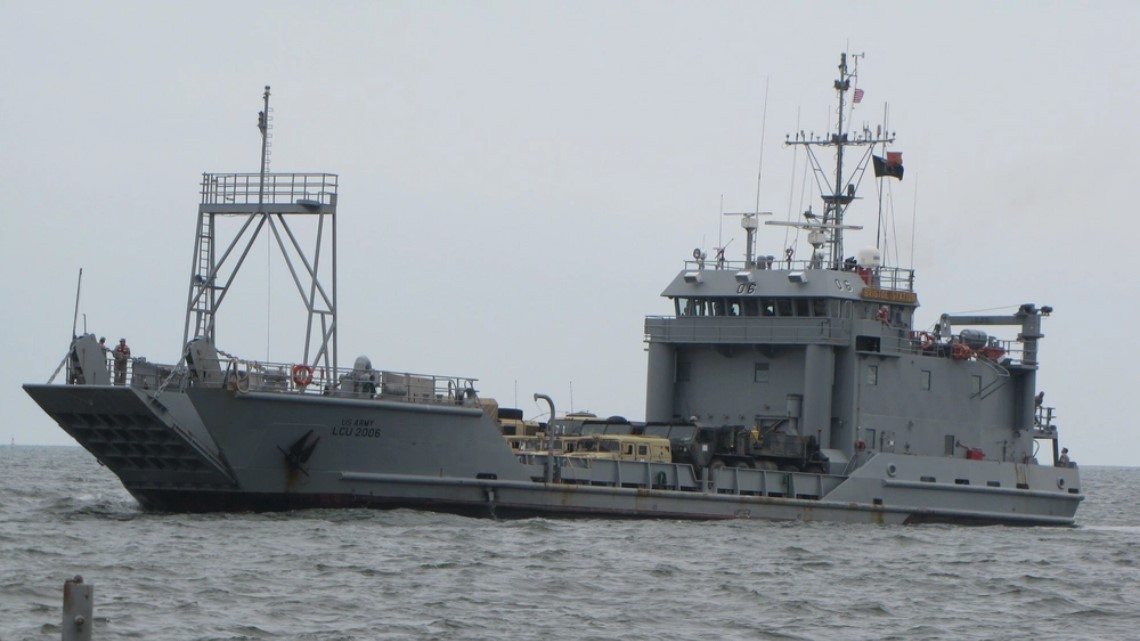

Fewer than half of the U.S. Army’s watercraft are meeting mission readiness requirements. That decline in operational capability comes as the military calls on those ships’ use more and more, according to a new report from a government watchdog.
The report from the United States Government Accountability Office found that the Army’s fleet of ships are undermaintained, often stuck in lengthy repairs, and increasingly unable to meet mission requirements. The GAO report found that of the 70 ships currently in service, only 40% are deemed mission capable, meaning that they can readily carry out their missions. That’s a sharp decline from just four years ago, when 75% of the watercraft fleet was deemed able to meet that readiness requirement. According to Army policy, 90% of equipment must be mission capable, including its boats.
“Army officials stated that these low mission capable rates, along with the smaller size of the watercraft fleet after divestment, hinder operational readiness and the ability to meet mission requirements,” the report says. “Army officials also stated that with such low rates, usually fewer than half the vessels in the fleet are available at any given time. In addition, officials told us that low mission capable rates and subsequent lack of vessel availability affect the Army’s ability to conduct training for watercraft personnel on vessels.”
First, yes, the U.S. Army has boats. It’s not just the Navy and Coast Guard that go out on the water. The Army maintains dozens of ships, for a variety of purposes. There was a time the fleet was much larger. In World War II, the Army had thousands of ships of various natures, from hospital ships to transport vessels. In 2018, the Army had 134.
As of May 2024, that number has almost been cut completely in half. The Army maintains 70 ships. Two are used by the Army’s Training and Doctrine Command, while the rest are under Army Forces Command and the U.S. Army Pacific. Three of the four bases used for the ships are in the Pacific.
“The challenges facing the Army’s current watercraft fleet are wide-ranging and include a reduced number of vessels in the fleet after divestment,” the GAO wrote. “These challenges limit the Army’s ability to meet mission requirements in the Indo-Pacific theater where the need for Army watercraft is most pronounced.”
The decline in readiness stems from several factors. Many of the ships are aging, and those that are still in service are plagued by maintenance issues and long delays. Meanwhile, the GAO found that manuals for the watercraft are out of date, and some systems are using handwritten services.
The issues plaguing the Army’s watercraft gained a spotlight earlier this year when the military deployed Joint Logistics Over The Shore or JLOTS, the modular pier system to Gaza. The JLOTS was meant to create a humanitarian bridge into Gaza while avoiding putting American troops inside the territory. The pier was plagued with issues and broke twice. It was eventually disassembled after only 20 days in operation. The Army boats that helped transport the material and support for it were found to have maintenance issues. In May, four Army ships ended up running aground due to rough seas.
Subscribe to Task & Purpose today. Get the latest military news and culture in your inbox daily.
All of this comes as the United States military is working on implementing new strategic moves in the Indo-Pacific theater. The Army’s ability to help transport material via the sea plays a critical role in that, and demand for its ships are up. However the GAO found that “the current number of Army watercraft vessels operating in the Indo-Pacific theater is insufficient to support INDOPACOM’s most stressing operation plan.”
The Army is working on a plan for modernizing its fleet by 2040, but the watchdog found that not enough is being done to deal with short-term and near-future issues. The Army has been working to extend the life and range of its current fleet — with updates ranging from newer motors to enhanced electronic and computer systems — but the report said that “it has not fully considered potential options” for addressing the increased demand and ongoing issues.
The GAO recommends that until the new modernization plan is finalized and implemented, the Army should develop a plan to mitigate mission readiness issues in the near term, in addition to finding ways to address ongoing maintenance issues and delays.
The latest on Task & Purpose
- Inspired by son, father reenlists in Navy 20 years later
- National Guard major sets burpee world record
- National Guard investigates Black Hawk filmed flying low over hurricane relief site
- Why Lionel Richie’s face is on the side of a Chinook in North Carolina
- How Moody Air Force Base rode out a direct hurricane hit
